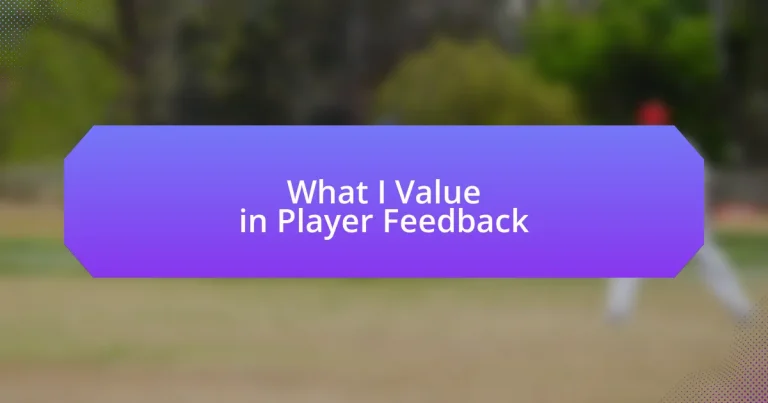Key takeaways:
- Player feedback is essential for game development, fostering innovation, trust, and community engagement.
- Utilizing a mix of feedback methods, such as in-game surveys and social media polls, yields richer insights into player experiences.
- Effectively analyzing feedback involves identifying themes, understanding emotional responses, and differentiating between constructive and non-constructive comments.
- Clear communication of changes based on player feedback, along with transparency about the reasoning behind those changes, strengthens player relationships and enhances community trust.
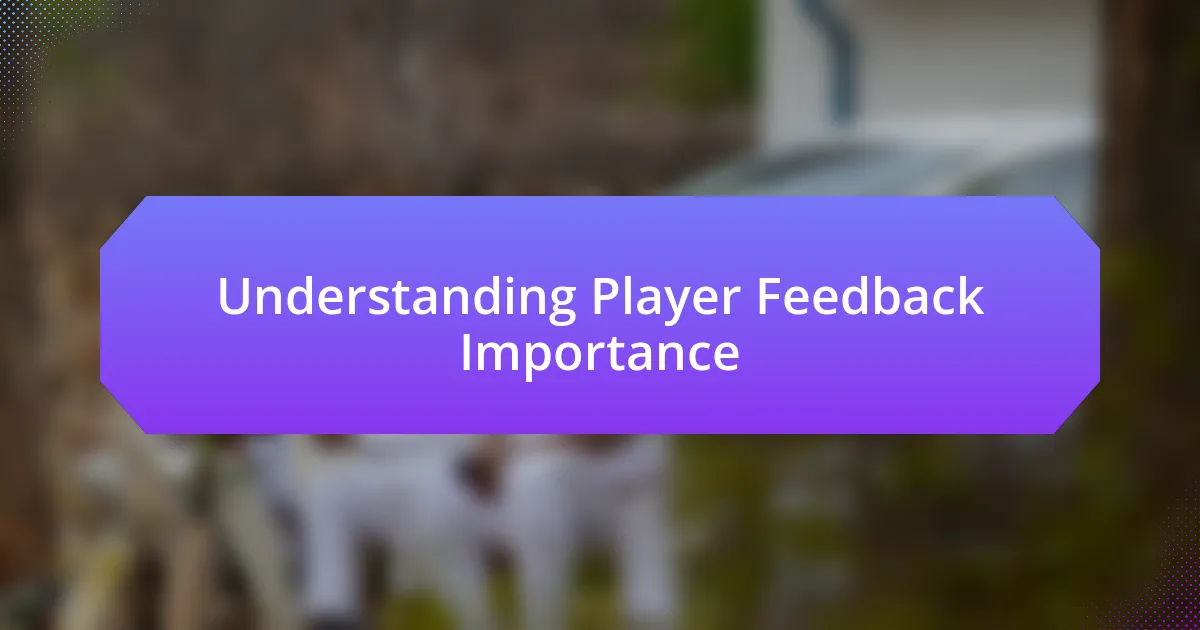
Understanding Player Feedback Importance
Player feedback serves as a crucial bridge between developers and the gaming community. I remember when I first released a game; the feedback felt like a guiding star, illuminating what worked and what didn’t. Without those insights, I wonder how many missteps I would have taken, leading to unfulfilled player experiences.
It’s fascinating how feedback can spark innovation. A player once pointed out a minor feature that wasn’t working as intended. That small insight led to an overhaul that transformed the game’s dynamics, creating a vibrant community around it. Isn’t it amazing to think how a single comment can influence the entire trajectory of a game?
Listening to players also cultivates a sense of trust and connection. I often think about how a positive relationship with players can enhance their investment in the game. When players feel heard, they are more likely to engage deeply, leading to loyalty and a richer gaming experience. How can any developer overlook that treasure?
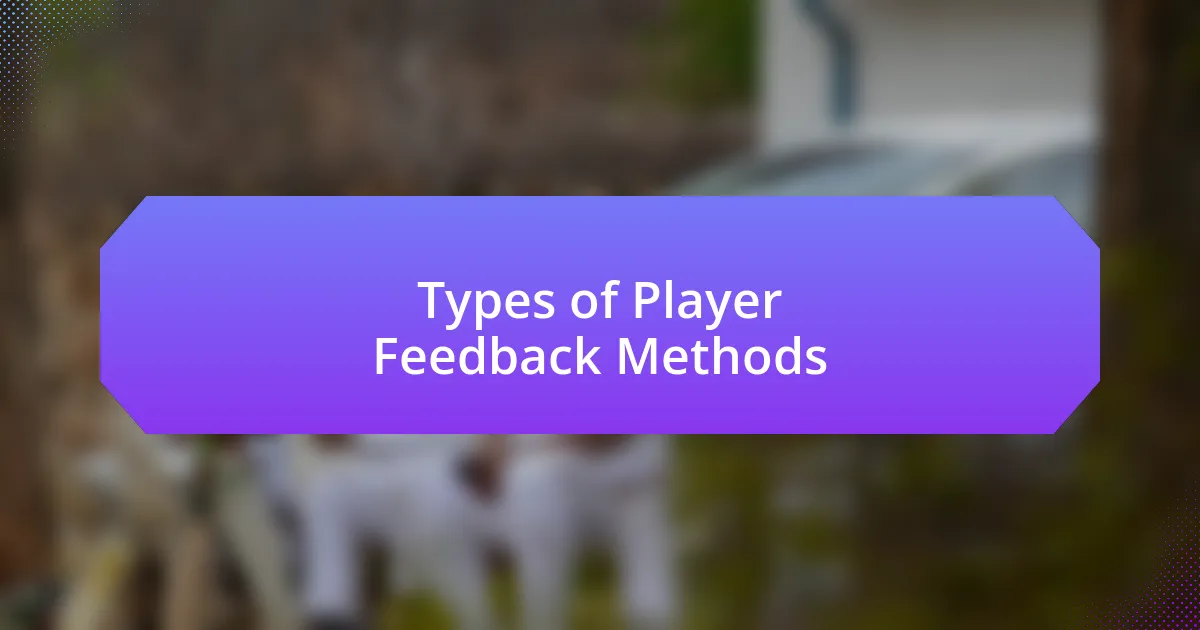
Types of Player Feedback Methods
There are various methods for gathering player feedback, each with unique benefits and drawbacks. Personally, I find that in-game surveys offer a direct way to understand player sentiment in real-time. One time, I embedded a quick survey right after a major update, and the immediate responses helped me gauge the community’s reaction before committing further resources. However, I always remind myself that surveys can sometimes miss the nuances of player experiences.
Here are some common methods I’ve encountered in my journey:
- In-Game Surveys: Quick pop-ups or forms asking players specific questions post-gameplay.
- Community Forums: Platforms where players can voice their opinions, suggestions, and critiques.
- Social Media Polls: Engaging players through platforms like Twitter or Instagram for instant feedback.
- User Testing Sessions: Observing players interact with the game in a controlled environment to see their reactions firsthand.
- Review Aggregators: Reading player reviews on platforms like Steam or mobile app stores to identify patterns and common themes.
Each method has its place, and I always prefer a blended approach to capture a richer tapestry of player insights.

How to Collect Player Feedback
Collecting player feedback is an essential part of game development, but how you gather that feedback can greatly affect the quality of the insights you receive. I’ve learned that combining different methods can yield the best results. For instance, while I’ve seen great results from using in-game surveys, I often complement them by diving into community forums. It’s fascinating to see how discussions evolve over time, giving context to the raw data I collect.
One memorable experience came from hosting a user testing session. Watching players engage with our game in real-time revealed subtleties that numerical data simply can’t capture. A player’s moment of frustration or joy during these sessions often spoke volumes about their experience, providing insights that shaped our following patches. It taught me the value of having that personal interaction, and I now prioritize it alongside quantitative methods.
A quick look at social media, for example, can reveal what players are thinking in real-time. When I tweeted out a simple poll on a gameplay mechanic, the flood of responses taught me so much about the player’s preferences. It was thrilling to see opinions differ widely, providing me an immediate pulse on the community’s thoughts.
| Feedback Method | Description |
|---|---|
| In-Game Surveys | Quick feedback forms that players fill out after gameplay sessions. |
| Community Forums | A space for players to discuss and share their thoughts over longer conversations. |
| Social Media Polls | Instant feedback through platforms like Twitter, gauging player opinions quickly. |
| User Testing Sessions | Hands-on observation of players interacting with the game for nuanced insights. |
| Review Aggregators | Analysis of player reviews from various gaming platforms to unearth trends. |
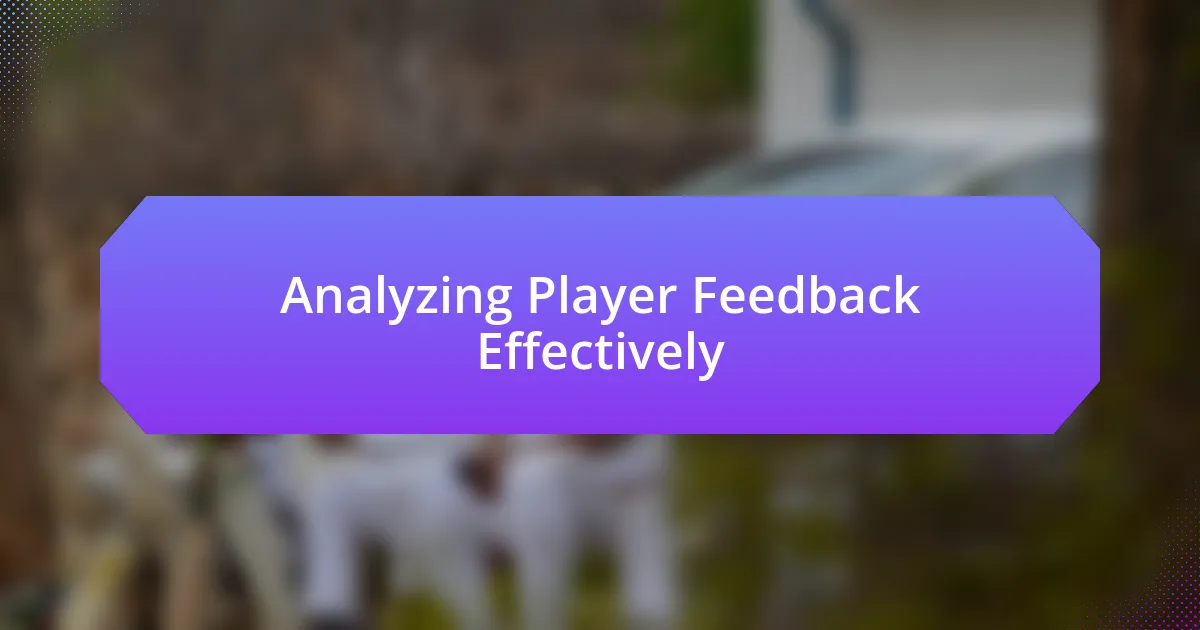
Analyzing Player Feedback Effectively
Once feedback rolls in, it’s crucial to sift through it systematically. I often categorize comments into themes, which helps in identifying patterns. For instance, I recently noticed a cluster of feedback about difficulty spikes in a specific level. Did this reveal an issue, or was it more about player expectations? Exploring these nuances helped me make targeted improvements.
When analyzing player feedback, I also pay attention to the emotional undertones of comments. I recall a case where a player expressed their feelings about a character’s storyline that resonated deeply with them. This connection highlighted not just a narrative strength, but also a potential opportunity to expand on character development in future updates. It’s a powerful reminder of how emotional engagement can inform our decisions.
I think it’s important to remember that not every piece of feedback will be constructive or actionable. Sometimes, players can be overly harsh or overly lenient. I’ve learned to approach these with a discerning eye, asking myself: What’s the core issue driving this response? By filtering through the noise and focusing on detailed, actionable insights, I can turn criticism into an opportunity for growth.
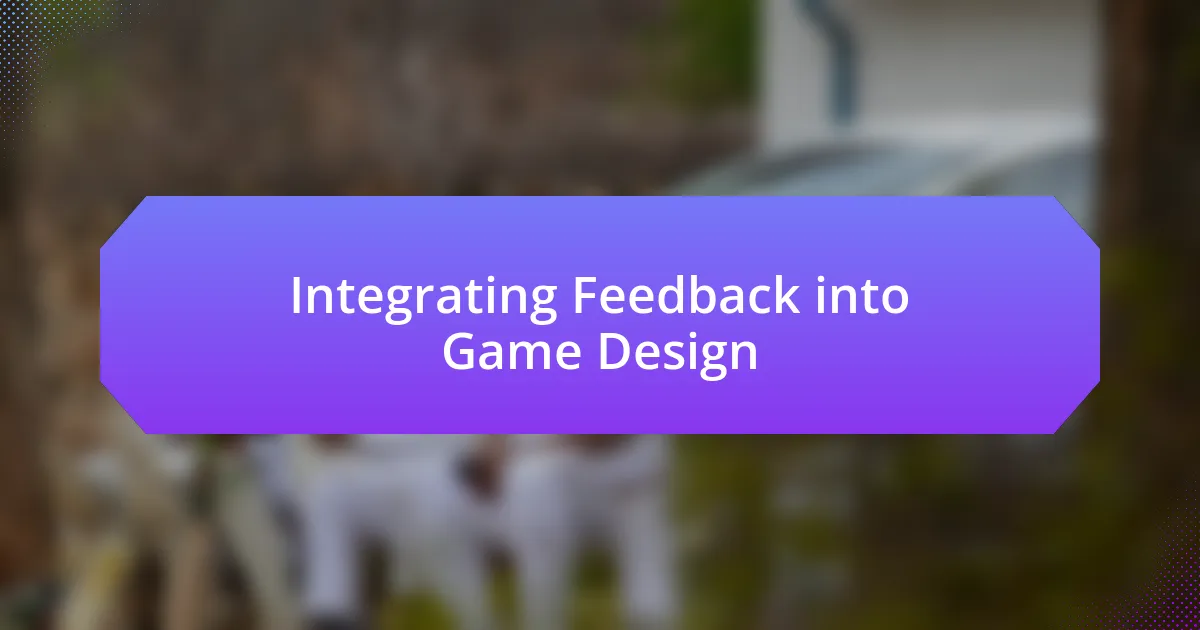
Integrating Feedback into Game Design
Integrating player feedback into game design is nothing short of a dynamic process. I remember integrating a player’s suggestion to modify a crafting system. Initially, it was just a minor adjustment, but the ripple effect enhanced overall gameplay satisfaction. Could it be that a simple tweak can spark a fresh wave of enthusiasm among players? That experience certainly showed me the power of thoughtful integration.
Being open to feedback means being ready to pivot. I’ve encountered moments when I needed to overhaul a feature after receiving consistent feedback that it didn’t resonate. The emotional weight of those decisions can be significant—sometimes, it feels like a personal reflection of my work. Yet, honing in on what players truly want, even if it means letting go of something I once loved, teaches me resilience and flexibility in design.
Ultimately, integrating feedback isn’t just about making changes; it’s about fostering a dialogue with the player community. When I initiate discussions on forums or social media, I often find gems of insight that profoundly influence design choices. This ongoing conversation not only strengthens relationships with players but also helps me build games that genuinely reflect what the community values. Isn’t it fascinating how collaboration can lead to unexpected innovations?
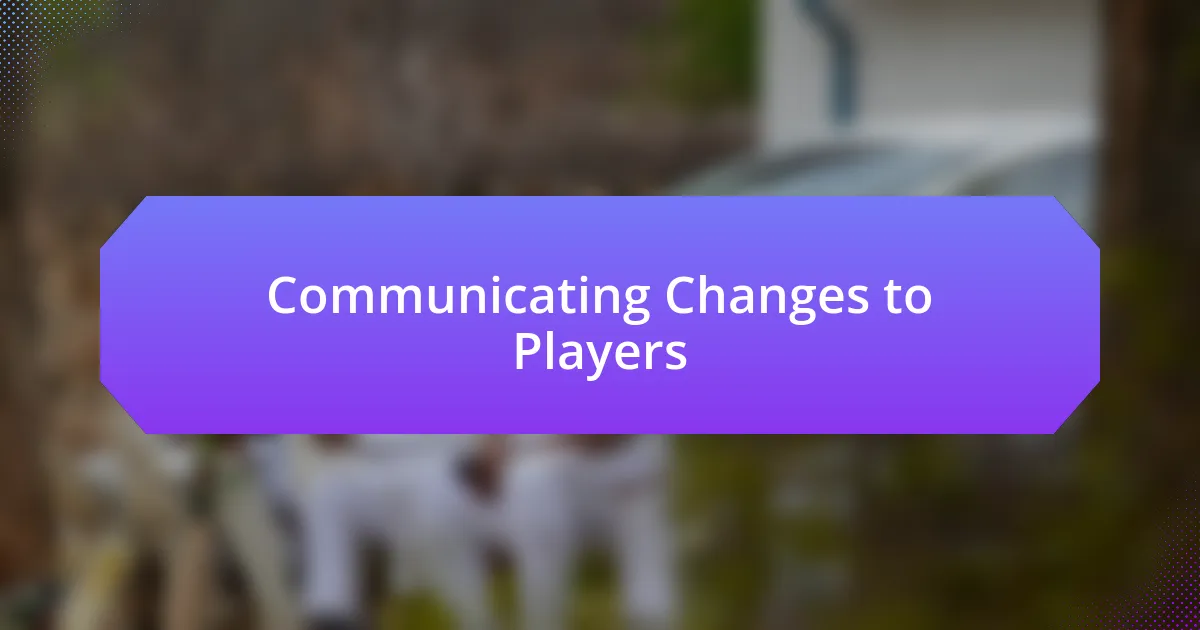
Communicating Changes to Players
When it comes to communicating changes to players, clarity is key. I recall a time when we revamped the user interface based on player feedback. Instead of a vague announcement, we created an engaging video that highlighted the new features. The response was overwhelmingly positive, and players appreciated that we took the time to thoughtfully explain our decisions. Is it any surprise that a visual representation can create more excitement than just words on a screen?
Another crucial aspect is being transparent about the reasons behind certain changes. I’ve learned that when players understand the “why,” they are much more likely to embrace the adjustments. For example, after we adjusted game balance in response to competitive player input, I shared data and insights that guided our decision-making process. It was rewarding to see players discussing the changes with enthusiasm rather than resistance, reinforcing my belief that honesty breeds trust.
Lastly, timing can make a significant difference in how changes are received. I’ve found that announcing changes during or after a major game update can be much more effective than during quieter periods. For instance, when we released a big patch, I made it a point to highlight both the feedback we integrated and the changes it inspired. This approach not only showcased our commitment to player involvement but also kept the community buzzing with excitement. What have your experiences taught you about the timing of communication?
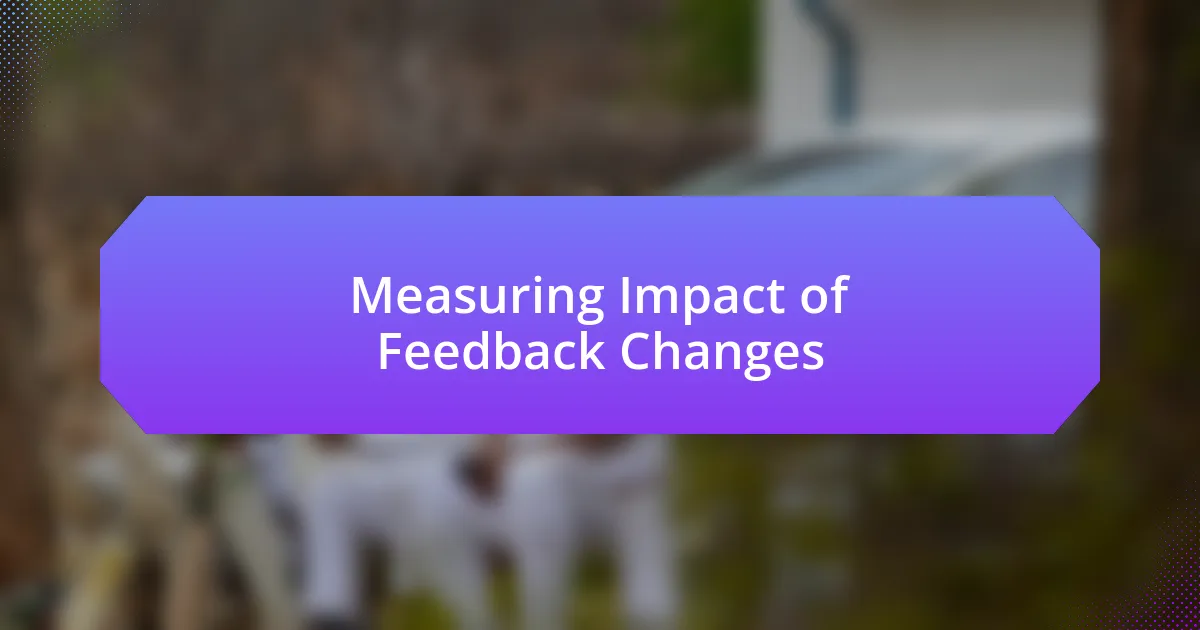
Measuring Impact of Feedback Changes
Measuring the impact of feedback changes is essential for understanding what resonates with players. I remember implementing a feedback-driven adjustment in game mechanics, and we decided to track player engagement through in-game statistics. This numerical data provided us with a clear indication of whether our changes were positively influencing gameplay, and seeing those numbers rise was incredibly validating.
Another avenue I explored was gathering qualitative feedback. After a major redesign based on player suggestions, I set up a survey to collect players’ thoughts and feelings about the new experience. Their candid responses not only highlighted the immediate improvements but also pointed out areas for further refinement. This back-and-forth dialogue truly illuminated how vital it is to not just collect feedback, but to actively listen and adapt.
I often think about the emotional impact of these changes. When I shared the results of our feedback revisions with the community, the excitement was palpable. Players expressed appreciation for feeling heard and valued, which reinforced the idea that measuring impact isn’t just about data—it’s about fostering a relationship. How do you gauge the emotional response of your players when implementing feedback? In my experience, it’s a blend of metrics and meaningful connections that truly showcases the impact of our efforts.












